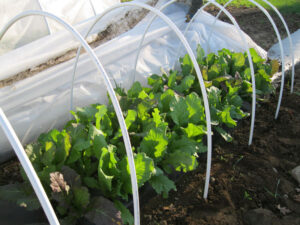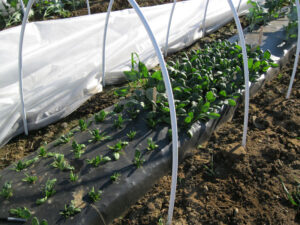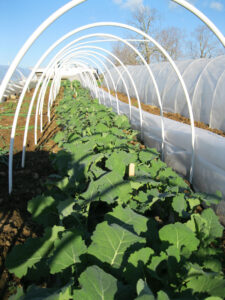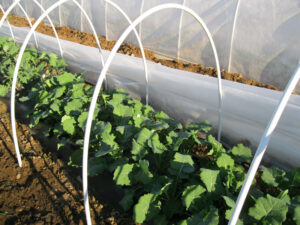2010 Annual Report for LNE10-297
Expanding winter harvest and sales for New England vegetable crops
Summary
Field-based educational programs in NH, MA and ME reached 385 farmers who increased their knowledge of winter production and storage practices and plan to implement new practices. Eight growers agreed to advise the project and met with project staff through conference calls to evaluate research plans, survey tools, and grower needs. At four farms and two research stations, low tunnels with different coverings were established and are being monitored over the winter 2010-2011. Project partners are organizing new and larger farmers markets to expand winter marketing opportunities for vegetable growers. The results of an ongoing survey of vegetable growers who subscribe to UMass Vegetable Notes, strong attendance at grower meetings, and increasing participation by vegetable growers in farmers markets all point to strong engagement of vegetable farmers in winter production, storage and sales.
Objectives/Performance Targets
The project began on 5/15/2010; hence, the following report covers the first seven months of this three-year project.
75 vegetable growers in New England increase their annual income from sales of vegetable crops during the months of December through April, by an average $6750 per farm. This will be accomplished through extending their production and harvest season or through expanding successful storage of fall-harvested crops, or both.
Farmer advisory committee meets with project team and refines project plans. Four farms and two research stations establish low tunnel trial. (Early in Year 1, June-November 2010)
• Eight growers, from NH, RI, MA and CT, agreed to serve as a core advisory group to guide the project and participate at various levels in project activities.
• Conference calls were held on July 2, November 22 and December 1; the latter was attended by all eight growers.
• Four growers in the advisory group and two research stations (MA and NH)established low tunnel trials, October 2010.
225 New England farmers attend winter farm tours, field days, and winter vegetable workshop and 30 growers join ‘interest networks’. As a result, at least 200 obtain new information about production, harvest, storage, farm planning, and marketing for winter. Sixty farmers provide information on their current production, storage, and marketing and define goals relating to winter sales. (Year 1, June 2010 to May 2011).
• 385 growers have attended winter farm tours, field days, and winter vegetable workshops in the first 7 months of this project.
• 75% of the growers who responded to exit surveys reported obtaining new information about production, harvest, storage, farm planning, and marketing for winter.
• Based on input from growers in the advisory group we have established a listserve to serve as one conduit of information exchange among growers interested in winter growing and winter sales.
• On December 20, 2010 we launched an online survey through MA and NH Extension newsletter lists, as well as CISA and SEL farmer contact lists (see appendix) to gather information on their current production, storage, and marketing and define goals relating to winter sales
Four farms and research stations repeat low tunnel trial; two farms host tours. 200 farmers attend farm tours, field days and workshop and learn strategies to increase harvest and sales. Forty growers improve storage facilities or change production or storage practices. 40 farmers expand winter sales. 500 farmers visit Winter Harvest website, 1000 receive fact sheets and articles. Advisory committee reviews and adjusts project activities. (Year 2, June 2011 to May 2012)
-None of these specific milestones were reached in 2010. Steps that will contribute to these milestones include:
-Additional winter farmers markets: 3 new market locations and twenty new farmers market days in seacoast NH and Connecticut Valley of MA were organized by project participants
-Increased participation of vegetable growers: existing markets added 15% more farmer vendors and 25% more vegetable farmers.
Accomplishments/Milestones
Farmer advisory committee meets with project team and refines project plans. Four farms and two research stations establish low tunnel trial. (Early in Year 1, June-November 2010)
Eight growers, from NH, RI, MA and CT, agreed to serve as a core advisory group to guide the project and participate at various levels in project activities (see S3M1 Members of Advisory Group). Conference calls were held on July 2, November 22 and December 1; the latter was attended by all eight growers. The farmers’ diversity of location (central NH to southern of RI; coastal to interior), experience with winter growing, size, and markets provide the project with different perspectives. All members are investing in equipment, infrastructure and labor to expand their winter storage and/or production through season extension (new or improved storage infrastructure, low tunnel, high tunnel, greenhouse) and are increasing winter sales through CSA, farmers market, and wholesale.
• Grower input:
Growers reviewed our online survey (http://www.surveymonkey.com/s/2WYDLPS) and gave feedback.
We discussed low tunnels, storage needs and concerns, and the best way to foster information exchange.
Growers gave input on the potential niche that low tunnels can provide (including taking pressure off higher-value hoophouse and greenhouse space, increasing yields and harvest for late fall and early spring, and overwintering crops as well as identifying their information needs and production questions.
Regarding harvest and storage, growers are grappling with a lot of questions on harvesting and handling efficiency and equipment especially as production scale ramps up; how and where to invest in storage for root crops and squash (build vs. rent, what to build), managing humidity and multiple microclimates for different crops (T/RH combinations). Most are expanding this aspect of their business so they face questions about scale and investment/return.
While they like live discussions at meetings for information exchange, many expressed that online information exchange (blogs, online discussions, Youtube videos) are very valuable for growers, and easier to access than travel to meetings.
A listserve has been established for ease of communication.
The research objective is to determine the temperature moderating effects of low tunnels constructed of various materials. Three tunnel coverings were selected for comparison based on temperatures observed in 2009-2010 pilot studies conducted in Durham NH. These were 1) two layers of DuPont5131 row cover (heavyweight 1.25 oz./sq. yd cover with 68% light transmission) 2) one layer of DuPont5131 row cover plus 4 mil greenhouse plastic and 3) one layer of DuPont5131 row cover plus 2 mil perforated plastic row cover from Dubois Agrinovation. Three low tunnels were established in Fall 2010 on each of six farms in a wide geographic range (see below). In each tunnel, Hobo UA-002-08 pendant data loggers were deployed to collect temperature data in the three tunnels with a nearby uncovered location as a control. On research station sites, Spectrum Technologies Watchdog 1000 series weather stations were also used in conjunction with Quantum light sensors to measure photosynthetically-active radiation (PAR). We had initially planned to keep the tunnels at farm sites empty, so that crops did not interfere with temperature collection. In consultation with our farmer core advisory group, we decided to relax this requirement; so that in some cases, low tunnels were placed over planted crops (e.g. spinach, onions). See S3M1 Locations of Low Tunnel Trials for name and location of farms with tunnel trials. See S3M1 Low Tunnel Methods for details on how trials are laid out at each farm.
A second research objective is to evaluate the effects of varieties and planting date on overwintering survival and spring yields of hardy vegetable crops. Although our initial plan was to delay these experiments until Fall 2011, crops were established in low tunnels in Durham NH as pilot studies, to give us the experience we need to design the 2011 studies. Hardy greens crops were selected for these preliminary studies. In a design with minimal replication (2 reps), plots were established in September 2010 of transplanted ‘Santee’ and ‘Happy Rich’ broccoli, ‘Siberian’ and ‘Red Russian’ kale, mustard (seed from UMass), and both direct-seeded and transplanted ‘Space’ spinach. Plots were established on both bare ground and black plastic. Low tunnels were covered with DuPont5131 row cover plus 4 mil greenhouse plastic as soon as they were transplanted. Inspection on 11/18/10 revealed considerable growth; as a result, half of each plot was harvested and the remainder was left to overwinter undisturbed. Yield, disease, and other data from these trials will be used to guide the design of replicated trials next fall. See S3M1 Broccoli UNH tunnel 12 10 10, S3M1 Mustard UNH tunnel 12 10 10, S3M1 Siberian kale UNH tunnel 12 10 10 and S3M1 Spinach UNH tunnel 12 10 10 for photographs of these crops in low tunnels on December 10, 2010.
225 New England farmers attend winter farm tours, field days, and winter vegetable workshop and 30 growers join ‘interest networks’. As a result, at least 200 obtain new information about production, harvest, storage, farm planning, and marketing for winter. Sixty farmers provide information on their current production, storage, and marketing and define goals relating to winter sales. (Year 1, June 2010 to May 2011)
Educational programs connected with this project were held in MA, NH and ME. See S3M2 Educational Programs 2010 for details.
The NH High Tunnel Programs were full day events (see S3M2 NH High Tunnel Programs). Evaluations (n= 38) of the Crop Production program ranked ‘Usefulness & relevance of presentations’ an average of 4.3 or higher on a scale of 0-5 (1 = not at all, 5 = extremely useful) for five of the six sessions. Producers listed the following likely actions or changes:
-Improved nutrient management – soil, tissue or compost testing (12),
-better sanitation or air flow or treat seeds (12),
-new crops or varieties, brambles: 6, broccoli: 3, other: 6,
-take steps to get a new tunnel (4);
-planning,
-data collection and record-keeping (5).
Three plan to grow only in winter, 8 only in summer, and 22 plan to grow year round.
UMass programs included three field-based tours. The UMass Crops Research and Education Farm hosted 136 people for 5 concurrent tours including a vegetable crops tour discussing research on storage carrots and low tunnels (60 attendees). Bolton Flats Mentor Farm hosted 76 participants to learn about the construction and use of high tunnels. Sixty people came to Indian Head Farm in Berlin to learn about using shelled corn for greenhouse heat and using high tunnels for vegetable, fruit and flower crops.
UMass Agriculture programs have been experimenting with evaluation tools that ask participants to rate their level of knowledge and their likelihood of using certain practices or ideas before and after the program. The ratings are ‘none, ‘minimal’, ‘moderate’ and ‘considerable’. These tools were used at the UMass Field Day and the twilight meeting at Indian Head Farm. This format allows numerical summary of the amount of increase in knowledge and likelihood of using a given practice. Our source for these evaluation tools is Penn State online program evaluation resource, http://extension.psu.edu/evaluation/.
Evaluations from the UMass field day tours indicated that 75% of 20 responders obtained new information about producing root crops for winter sales, and 57.5% of 21 responders obtained new information about using low tunnels for season extension. At the Indian Head Farm twilight meeting, exit surveys indicated that 85% of the 26 responders had increased their knowledge of options for vegetable production in high tunnels, and 78% indicated that they were more likely to try something new as a result. 77% reported an increased understanding of pest management issues in high tunnel production, with 60% reporting that they were more likely to try new methods after the meeting. 65% indicated a better understanding of the economics of high tunnel production as a result of the meeting.
In total, 385 growers have attended winter farm tours, field days, and winter vegetable workshops in the first 7 months of this project. Of the 105 growers who responded to exit surveys at various meetings, 75 directly reported an increase in knowledge.
Publications. In addition to the targeted outreach above, UMass Extension also included nine articles on topics related to season extension, storage, or winter production & sales in the Vegetable Notes newsletter (subscription base of ~1,000). For titles see S3M2 Vegetable Notes List of Articles on Winter Production and Storage. For complete text see S3M2 Vegetable Notes Articles on Winter Production and Storage.
An ongoing research project at UNH has resulted in a body of information about growing and marketing winter sprouting broccoli in high tunnels as a new and exciting crop for early spring markets. Becky Sideman published this fact sheet in newsletters and it was also published in UMass Vegetable Notes. See S3M2 Winter Sprouting Broccoli Fact Sheet 2010
Grower Networks. Based on input from growers in the advisory group we have established a listserve to serve as one conduit of information exchange for grower interest groups. This list will become active in early 2011, beginning with the project advisory group and expanding to include a wider circle of growers.
Grower Surveys and Interviews. Survey instruments are being developed for baseline information about grower practices and incomes, to help us to measure our impact and our performance target. One survey (see S3M2 Winter Growers Survey or http://www.surveymonkey.com/s/2WYDLPS)is being offered through Survey Monkey, to a broad group accessed through newsletters, meetings, and farm visits. Baseline winter income information will be obtained through this instrument along with farmer, farm, marketing characteristics and information needs. This is being sent out in December 2010 – January 2011. We will also use a more detailed interview form for direct farm visits or conversations, to assess current status of storage infrastructure and season extension techniques, again with needs assessment built in. These instruments will help us to establish baseline information for current production, storage, and marketing and define goals relating to winter sales for at least 60 growers.
Vegetable Notes Articles on Winter Production and Storage
Winter Sprouting Broccoli Fact Sheet
Four farms and research stations repeat low tunnel trial; two farms host tours. 200 farmers attend farm tours, field days and workshop and learn strategies to increase harvest and sales. Forty growers improve storage facilities or change production or storage practices. 40 farmers expand winter sales. 500 farmers visit Winter Harvest website, 1000 receive fact sheets and articles. Advisory committee reviews and adjusts project activities. (Year 2, June 2011 to May 2012)
In order to increase grower’s ability to sell high quality produce in winter, we are conducting research on carrots in storage. The quality of carrots in long-term storage depends on many factors including cultivar, production practices, temperature and conditions before and during harvest, postharvest handling, and storage conditions.
Carrot Research: Harvest Date & Varieties for Long-term Storage
Our research objective for year 1 was to determine effect of carrot variety and date of harvest on storage life and quality. This experiment was conducted in 2010 and the storage component is underway at the time of this report. Storage carrot varieties were selected to represent several carrot types with varying maturity dates, based on recommendations of growers and breeders (See S3M3 Varieties for UMass Storage Carrot Experiment 2010). Bolero, a heavy Nantes type, seems to be the most widely grown storage carrot among diversified vegetable growers in New England. We chose Chantenay, Berlikum and Imperator types for comparison (See photos S3M3Bastia, S3M3Berlanda, S3M3Bolero, S3M3Carson, S3M3Canada, S3M3Sugarsnax). Carrots were seeded on June 28, using a Clean Seeder, in double rows 18 inches apart, then hand weeded, and thinned to 1 inch on July 28. We learned that carrot seed varies significantly in size, requiring changes in seeder plates. Trickle irrigation was surface-applied along each row as needed for germination and growth. Carrots were harvested every two weeks during the fall, starting on 9/29 (93 days post-seeding), 10/12, 10/27 and 11/10 (130 days post-seeding) and graded based on USDA standards into one of the following categories: marketable, forks, misshapen, split, small, or insect damage (see photos S3M3Bolero misshapen, S3M3Bolero forks, S3M3Carson insect dmg). Later harvests, which extended the days to harvest long past expected maturity, produced some russetting regrowth of side roots in early varieties (see S3M3 Bolero hairy). Further review of carrot standards used in local farmers markets indicated that the categories of forks and misshapen would, for the most part, also be marketable in CSA’s and farmers markets. Thus, as is often true, ‘marketability’ depends on the intended market.
Preliminary results (without statistics) are presented in two graphs: S3M3Percent of Carrots (by number) in Each Grading Category; Avg. of Four Harvest Dates and S3M3 Weight (lb) of USDA-Grade Marketable Carrots by Cultivar and Harvest Date. We took measurements on marketable carrots of each cultivar at harvest, including brix, weight, length, widest diameter, pith diameter, bitterness. A subsample of marketable carrots were placed into storage at 34 degrees F (+/- 2 degrees F) and RH>95% immediately after each harvest. A subset from each variety and harvest date will be sampled monthly December to March. Measurements during storage include water loss, brix, and bitterness.
- Varieties for UMass Storage Carrot Experiment 2010
 Bolero
Bolero Bolero hairy
Bolero hairy- Percent of Carrots in Each Grading Category
 Bolero misshapen
Bolero misshapen Bastia
Bastia Berlanda
Berlanda Canada
Canada- Weight Marketable Carrots
 Sugarsnax
Sugarsnax Bolero forks
Bolero forks
Markets
In order to help expand farmers’ winter sales, participants in this project are organizing winter farmers markets in Coastal New Hampshire and the Connecticut Valley of western MA.
Coastal New Hampshire Markets.
History. Seacoast Eat Local sponsored 3 markets in 2007-8, and six in 2008-9. Based on overwhelming demand from market customers, and positive feedback from participating farmers, fishermen and food vendors, they decided to increase the frequency of the winter markets, and secure indoor spaces large enough to accommodate 40 to 50 vendors.
From November 2009 through April 2010, Seacoast Eat Local hosted 11 markets at 2 indoor locations – Wentworth Greenhouses in Rollinsford, NH and Exeter High School in Exeter, NH. Total vendors participating throughout the season: 65 (41 farms; 24 prepared food), with 16 farms selling vegetables (see S3M3 2009-10 Market Data from Eleven Markets Organized by Seacoast Eat Local)
March 2010 Farmer Focus Group
In March, Seacoast Eat Local convened a farmer focus group to determine the wants, needs, and
capacity of farmers for future seasons. These farmers confirmed that their goals included:
• More frequent markets in larger spaces that occur more consistently throughout the winter
• Increasing their farms’ growing capacity to ensure that the markets have the best possible diversity and availability of products for consumers
• Attending professional development opportunities such as workshops and skill shares
In response to the Winter Farmers’ Markets, several farmers changed their business models to take advantage of new “off-season” marketing opportunities. Changes include:
• Installing root cellars for storage of crops sold at winter farmers’ markets
• Installing hoophouses and greenhouses
• Offering winter CSAs as an additional outlet for greenhouse crops and storage crops
The Current Season: 2010-11 Winter Farmers’ Markets
• 6 new winter markets added for the winter of 2010-2011 (total of 11)
• Added 13 new farmer vendors
• Increased the % of farmer vendors from 63% to 77%
• Increased the # of farmers selling vegetables from 16 to 22
• New guidelines for prepared food vendors at winter markets require the use of locally grown ingredients. In order to make more room for farmers, we allocated a smaller number of spaces to non-farm food vendors this year (no more than 12 at each market).
• Seeing a significant increase in the quantity and diversity of vegetables farmers are bringing to the markets. Availability of specific vegetables on specific dates is being tracked throughout the winter.
Markets in the Connecticut River Valley (Hampshire, Hampden & Franklin Counties), MA. CISA sponsored or supported two ‘Winter Fare’ markets, which are large one-day farmers markets combined with workshops and other community events. Vendors were given surveys; 13 Northampton vendors of 24, and 15 Greenfield vendors of 29 returned their completed surveys. Their one-day income for each market is reported in S3M3 CISA’s Market Data from One-day Winter Fare Markets. ‘Dot’ surveys were offered to customers who numbered approx. 1750 in Northampton and 1200 in Greenfield.
The Current Season: 2010-11 Winter Farmers’ Markets.
Winter Markets in the Pioneer Valley (Hampshire, Hampden & Franklin Counties), MA.
• CISA is sponsoring an new Winter Fare market in Springfield (December 18), and continues to sponsor Northampton and assist with the one-day market in Greenfield (February 5).
• Two new weekly winter farmers markets have been established in Amherst, MA, with a total of over 26 vendors.
Winter CSA’s. In coastal New Hampshire, there are 10 winter CSAs listed in the 2010 edition of SEL’s Seacoast Harvest local food guide (www.seacoastharvest.org) which covers Rockingham and Strafford Counties in NH, and southern York County, Maine. Several of these CSAs offer year-round options. The previous year, there were just 2 or 3 farms offering late fall/early winter CSA shares and bulk ordering. In the Pioneer Valley of Western MA, 10 winter vegetable CSA’s are available in the three-county area. Further data on CSA’s and farmers markets will be collected from farms and customers over the course of the winter.
- Market Data from Eleven Markets Organized by Seacoast Eat Local
- CISA’s Market Data from One-day Winter Fare Markets
Impacts and Contributions/Outcomes
Current survey.
UMass Extension is in the midst of collecting survey data from the 1,000+ subscribers to our Vegetable Notes newsletter. The survey is meant to collect information on how Extension programs have affected growers, and also on what topics growers would like to see us cover in future programs. Current survey results (n= 150) point to a strong grower interest in topics related to season extension. When asked to rank their interest in certain topics, 84.6% of responders indicated that they were either somewhat interested (29.7%) or very interested (54.9%) in winter storage; 89.7% were either somewhat (27%) or very (62.7%) interested in season extension. In addition, when asked what changed they made to their production or marketing practices as a result of information provided by UMass Extension through meetings, newsletters, websites, or other means 80 growers (44% of responders) that they are using row covers, high or low tunnels for season extension as a result of information provided by UMass Extension; 50 growers (28% of responders) have adopted new methods for curing and/or storing winter squash, potatoes or other root vegetables as a result of our educational activities. These survey results corroborate our experience that winter production and marketing is a topic that is of growing interest to farmers.
Collaborators:
Winter Farmers’ Market Coordinator
Seacoast East Local
245 North River Rd
Epping, NH 03042
Office Phone: 6037344223
Website: http://www.seacoasteatlocal.org/
Program Coordinator
Community Involved in Sustaining Agriculture
1 Sugarloaf Street
South Deerfield, MA 01373
Office Phone: 4136657100
Website: http://buylocalfood.org/
Departmental Assistant
UMass Extension
250 Natural Resources Rd
Ag Engineering
Amherst, MA 01002
Office Phone: 4135773976
Extension Specialist and Associate Professor
University of New Hampshire
38 Academic Way
Durham, NH 03824-2617
Office Phone: 6038623203
Website: http://extension.unh.edu/
Associate Professor, Dept of Plant Soil and Insect Science/ Postharvest physiologist
University of Massachusetts
204A French Hall
University of Massachusetts
Amherst , MA 01003
Office Phone: 4135455228
Extension Educator
University of Massachusetts
250 Natural Resources Rd
Amherst, MA 01002
Office Phone: 4135453696
Website: www.umassvegetable.org
Departmental Assistant
UMass Extension
250 Natural Resources Rd
Ag Engineering
Amherst, MA 01002
Office Phone: 4135773976



